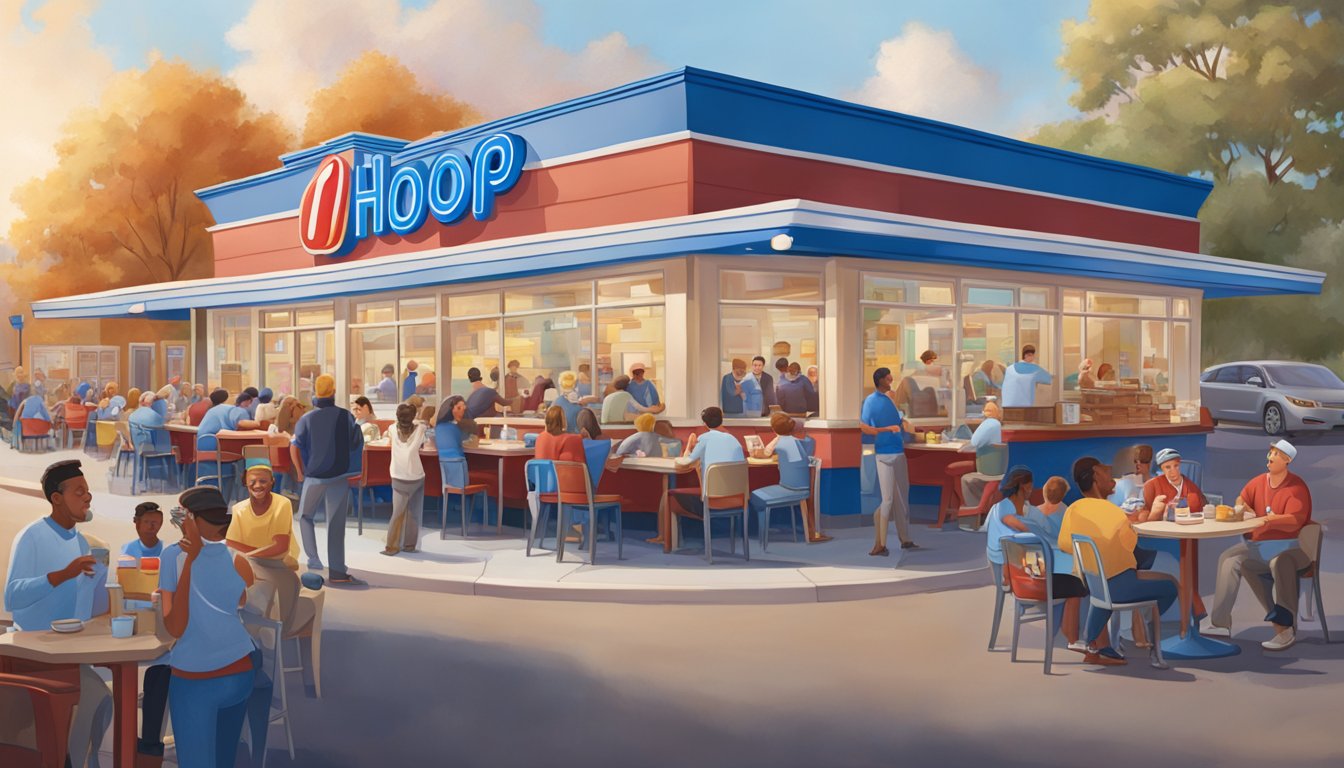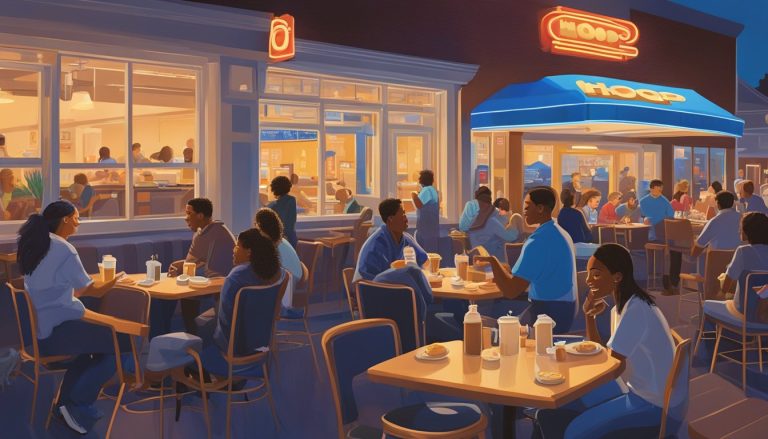IHOP, the International House of Pancakes, has become an iconic fixture in American pop culture since its founding in 1958. This beloved breakfast chain has woven itself into the fabric of everyday life, appearing in movies, TV shows, and music as a symbol of classic American dining.
IHOP’s influence extends beyond its menu, shaping breakfast habits and becoming a cultural touchstone for generations of Americans. From its humble beginnings as a small pancake house in Toluca Lake, California, IHOP has grown into a nationwide phenomenon, serving up comfort food and nostalgia in equal measure.
The chain’s popularity has transcended its origins, attracting not only families and late-night diners but also Hollywood stars. In its early years, IHOP was a hotspot for celebrities like Doris Day, Milton Berle, and Jimmy Stewart, adding a touch of glamour to its all-American appeal. This blend of accessibility and star power has helped cement IHOP’s place in the collective imagination of American pop culture.
The History of IHOP
IHOP’s journey from a single pancake house to a global restaurant chain spans over six decades. The company’s evolution reflects changing American tastes and business trends in the food service industry.
The Founding and Expansion
IHOP, originally known as International House of Pancakes, was founded by Al and Jerry Lapin in 1958. The first restaurant opened in Toluca Lake, Los Angeles, California. The Lapin brothers aimed to create a family-friendly dining experience centered around breakfast foods.
IHOP’s early success led to rapid expansion through franchising. By 1960, there were 50 IHOP locations across the United States. The company went public in 1961, fueling further growth.
In the 1970s, IHOP introduced its signature buttermilk pancakes and expanded its menu beyond breakfast items. This strategic move helped attract customers throughout the day, not just during morning hours.
Albert Kallis’s Contribution
Albert Kallis, a co-founder of IHOP, played a crucial role in shaping the company’s visual identity. As an accomplished commercial artist, Kallis designed IHOP’s iconic blue roof and A-frame architecture.
His designs became synonymous with the IHOP brand, making restaurants easily recognizable across the country. Kallis’s work extended to menu designs and promotional materials, creating a cohesive visual experience for customers.
The blue roof concept, in particular, became a landmark feature. It helped IHOP stand out in a competitive restaurant landscape and build brand recognition.
Global Reach
IHOP began its international expansion in the 1960s, opening its first restaurant outside the United States in Canada. The company’s global presence grew steadily over the following decades.
In 1969, IHOP opened its first location in Puerto Rico, marking its entry into the Caribbean market. The 1990s saw further expansion into Mexico, bringing IHOP’s American-style breakfast to Latin America.
IHOP’s reach extended to Asia in 2013 with the opening of restaurants in the Philippines. The Middle East became another important market, with Saudi Arabia hosting multiple IHOP locations.
Transformation into Dine Brands Global
In 2007, IHOP Corporation made a significant move by acquiring Applebee’s International for $2.1 billion. This acquisition marked a turning point in the company’s history.
Following the merger, IHOP Corporation changed its name to DineEquity, Inc. in 2008. The new entity became the parent company for both IHOP and Applebee’s brands.
In 2018, DineEquity rebranded as Dine Brands Global. This change reflected the company’s ambition to expand its portfolio beyond IHOP and Applebee’s.
Under Dine Brands Global, IHOP has continued to evolve. The company has experimented with new concepts, including IHOP Express for quick-service locations and virtual restaurant brands.
IHOP’s Brand Evolution

IHOP has undergone significant changes to stay relevant in a competitive market. The brand has embraced bold marketing strategies and updated its visual identity to appeal to changing consumer preferences.
IHOb: The Name Change Phenomenon
In 2018, IHOP made headlines with a temporary name change to IHOb. The “b” stood for burgers, highlighting the chain’s expanded menu beyond breakfast. This marketing stunt generated massive social media buzz and widespread speculation about the brand’s direction.
The campaign successfully drew attention to IHOP’s lunch and dinner offerings. It sparked conversations across platforms and increased burger sales. Though short-lived, the IHOb rebrand demonstrated IHOP’s willingness to take risks and adapt to market trends.
Restaurant Design and Branding
IHOP has modernized its restaurant aesthetics to create a more inviting atmosphere. The chain introduced a new logo in 2015, featuring a smiling face within the “o” to convey warmth and hospitality.
Interior designs now incorporate brighter colors and more contemporary furnishings. Digital menu boards and self-service kiosks have been added to enhance the customer experience. These updates aim to attract younger diners while maintaining the brand’s family-friendly appeal.
IHOP’s evolving visual identity reflects its commitment to staying fresh and relevant in the competitive dining landscape.
Menu Innovations

IHOP has continually evolved its menu offerings to meet changing consumer tastes and preferences. The restaurant chain has expanded far beyond its original pancake-centric focus to include a diverse array of breakfast, lunch, and dinner options.
Rise of Breakfast Foods
IHOP’s breakfast menu has grown significantly since the company’s founding. In addition to their signature pancakes, IHOP now offers a wide variety of morning favorites. Omelets, waffles, French toast, and breakfast combos have become staples. The restaurant has also introduced healthier options like egg white dishes and whole grain items to cater to health-conscious diners.
In recent years, IHOP has focused on premium breakfast offerings. New additions include gourmet egg dishes and specialty pancake flavors. The chain has also embraced breakfast trends like avocado toast and protein-packed bowls.
The Iconic Pancakes
Pancakes remain at the heart of IHOP’s menu and identity. The restaurant’s buttermilk pancakes are particularly famous, known for their fluffy texture and comforting taste. IHOP regularly introduces limited-time pancake flavors to generate excitement and keep the menu fresh.
Seasonal pancake offerings have become a tradition, with flavors like pumpkin spice in fall and red velvet around Valentine’s Day. The chain has also experimented with unique pancake creations, such as cereal-inspired varieties and savory options.
Beyond Breakfast: Burgers and Other Offerings
IHOP has made significant strides in expanding its lunch and dinner options. The introduction of Ultimate Steakburgers in 2018 marked a major shift in the restaurant’s menu strategy. These high-quality burgers aimed to compete with traditional burger chains and broaden IHOP’s appeal beyond breakfast hours.
The menu now includes a variety of sandwiches, salads, and dinner entrées. Comfort food classics like chicken and waffles have found a place alongside healthier options. IHOP has also embraced value-focused deals and family meal bundles to attract budget-conscious diners.
Cultural Impact

IHOP has woven itself into the fabric of American society through its widespread presence and clever marketing strategies. The restaurant chain’s influence extends beyond just serving pancakes, shaping dining habits and social traditions.
Integration into Daily Life
IHOP has become a familiar fixture in many communities across the United States. Its 24/7 operations in many locations have made it a popular late-night destination for college students and shift workers. The restaurant’s welcoming atmosphere has also turned it into a gathering spot for families and friends.
IHOP’s menu items, particularly its pancakes, have become part of the American culinary lexicon. The chain’s signature dishes like Rooty Tooty Fresh ‘N Fruity pancakes have entered popular culture references in TV shows and movies.
Social media has amplified IHOP’s cultural presence. The company’s witty posts and engagement with customers have helped maintain its relevance in the digital age.
National Pancake Day & Promotions
IHOP’s National Pancake Day has evolved into a widely recognized annual event. Launched in 2006, this promotion offers free short stacks of buttermilk pancakes to customers in exchange for optional donations to charity.
The event has raised millions of dollars for various causes, combining philanthropy with brand awareness. It has also sparked a trend of food-related “national days” that other restaurants have emulated.
IHOP’s marketing campaigns often generate significant buzz. The temporary “IHOb” rebrand in 2018, focusing on burgers, created widespread discussion and media coverage. Such promotions demonstrate IHOP’s ability to capture public attention and maintain cultural relevance.
Business Strategy and Performance

IHOP’s business strategy focuses on delivering value through its iconic breakfast offerings and expanding into new market segments. The company balances its casual dining roots with quick-service elements to drive growth and profitability.
Financial Stock Overview
IHOP operates under its parent company Dine Brands Global, which trades on the New York Stock Exchange. As of January 2025, Dine Brands Global stock has shown steady performance, reflecting IHOP’s continued market presence. The company’s financial reports indicate consistent revenue from IHOP’s operations, with same-store sales growth in recent quarters.
IHOP’s expansion efforts, including new restaurant openings and international franchising, have contributed to its financial stability. The brand’s emphasis on off-premises dining, particularly through takeout and delivery options, has bolstered sales figures.
Value Proposition and Marketing
IHOP’s core value proposition centers on providing a wide variety of breakfast items at affordable prices. The brand’s marketing strategy leverages this strength, focusing on its signature pancakes and all-day breakfast menu. IHOP regularly introduces limited-time offerings to attract customers and generate buzz.
Social media plays a crucial role in IHOP’s marketing efforts. The company engages with customers through platforms like Instagram and Twitter, sharing appetizing food images and running interactive campaigns. These initiatives aim to maintain IHOP’s cultural relevance and appeal to younger demographics.
Quick-Service vs. Casual Dining
IHOP straddles the line between quick-service and casual dining segments. While maintaining its sit-down restaurant format, the brand has incorporated quick-service elements to adapt to changing consumer preferences. This hybrid approach allows IHOP to cater to both leisurely diners and those seeking convenient meal options.
The company has invested in streamlining its kitchen operations and order fulfillment processes to reduce wait times. IHOP’s mobile app and online ordering system facilitate quick pick-up and delivery services. These initiatives have helped IHOP compete with fast-casual breakfast chains while retaining its traditional casual dining atmosphere and friendly service.
The Future of IHOP

IHOP aims to maintain its breakfast leadership while expanding into new markets and dayparts. The brand is focusing on innovation and adapting to changing consumer preferences to stay relevant in the competitive restaurant industry.
Innovation and Expansion Goals
IHOP plans to nearly double its product innovation efforts compared to previous years. This strategy aims to keep the menu fresh and exciting for breakfast lovers. The chain is also looking to expand beyond its traditional breakfast offerings, targeting lunch and dinner crowds.
IHOP’s parent company, Dine Brands Inc., is exploring potential mergers to strengthen the brand’s position. This move could lead to new restaurant concepts and expanded market reach.
International expansion remains a key focus. IHOP is actively seeking opportunities to bring its iconic pancakes to new countries, adapting menus to local tastes.
Adapting to Consumer Trends
IHOP is embracing digital technologies to enhance customer experience. Mobile ordering, contactless payments, and loyalty programs are becoming integral parts of the IHOP ecosystem.
The brand is also responding to health-conscious diners by introducing more nutritious options. This includes plant-based alternatives and lower-calorie menu items.
IHOP is experimenting with new restaurant formats, such as smaller footprint locations and ghost kitchens. These adaptations cater to the growing demand for convenience and takeout options.
Sustainability initiatives are gaining importance. IHOP is exploring eco-friendly packaging and sourcing practices to appeal to environmentally conscious consumers.
IHOP Locations and Unique Offerings

IHOP’s widespread presence and diverse menu offerings have made it a staple in American dining culture. The chain’s iconic locations and special menu items contribute to its enduring popularity.
Iconic Locations
IHOP boasts over 1,600 locations across the United States, with restaurants in 52 states and over 1,100 cities. Some IHOP locations stand out for their unique settings or historical significance. In Las Vegas, IHOP has integrated itself into the city’s vibrant dining scene. The IHOP at Aria Resort & Casino offers a convenient spot for tourists and locals alike to enjoy classic breakfast fare amidst the glitz of the Strip.
Another notable location is the 24-hour IHOP in Times Square, New York City. This bustling restaurant caters to the area’s round-the-clock energy, serving pancakes and other favorites to tourists, theatergoers, and night owls.
Special Menu Items
IHOP’s menu features a mix of classic offerings and innovative creations. The chain is renowned for its buttermilk pancakes, available in various flavors and styles. IHOP also offers seasonal specials, like pumpkin spice pancakes in the fall.
For those seeking heartier fare, IHOP serves USDA Choice steaks alongside eggs and pancakes. The restaurant’s “Unlimited Fries” promotion allows diners to indulge in endless crispy fries with select entrées.
IHOP has also adapted to changing dietary preferences. The chain now offers plant-based options, including Beyond Meat sausage, and gluten-friendly pancakes to cater to a wider range of customers.




